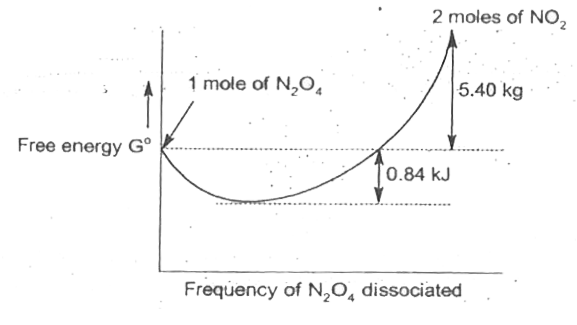A reaction is spontaneous if free energy change ΔG for the reaction is negative . The question arises, how we can explain , the spontaneous reversible reaction. Taking the example of dissociation equilibrium N2O4⇔2NO2(g) the variation of free energy with the fraction of N2O4 dissociated under standard conditions is shown in the figure below.

When 1 mole of N2O4 changes into the equilibrium mixture the value of ΔG∘ is
a) 0.84kJ
b) −0.84kJ
c) 5.40+0.84kJ
d) 0.84−5.40kJ
The correct Answer is:B
The lowest point of the plot represents equilibrium mixture. When 1 mole of N2O4 changes into equilibrium mixtture , free energy is lowered by 0.84 kJ, ΔG=−0.84KJ.
Similar Questions
A reaction is spontaneous if free energy change ΔG , for the reaction is negative . The question arises, how we can explain , the spontaneous of reversible reaction taking the example of dissociation equilibrium N2O4⇔2NO2(g) the variation of free energy with the fraction of N2O4 dissociated under standard conditions is shown in the figure below.

When 2 moles of NO2 change into equilibrium mixture the value of ΔG∘ is
View SolutionA reaction is spontaneous if free energy change ΔG , for the reaction is negative .
The question arises, how we can explain , the spontaneous reversible reaction taking the example of dissociation equilibrium ,N2O4⇔2NO2(g).
the variation of free energy with the fraction of N2O4 dissociated under standard conditions is shown in the figure below.

The standard free energy change for the conversion of 1 mole of N2O4 into 2 moles of NO2 is
View Solution
Knowledge Check
The degree of dissociation α of the reaction"
N2O4(g)⇔2NO2(g)
can be related to Kp as:Aα=KpP4+KpPBα=Kp4+KpCα=[Kp/P4+Kp/P]1/2Dα=[Kp4+Kp]1/2
The free energy change for a reversible reaction at equilibrium is
View SolutionWrite the equilibrium constant expressions for the following reactions.
N2O4g⇔2NO2(g)
View SolutionDiscuss the effect of increase of pressure on the following reactions
N2O4(g)⇔2NO2(g)
View SolutionThe degree of dissociation of N2O4(1) obeying the equilibrium,
N2O4(g)⇔2NO2(g), is approximately related to the pressure at equilibrium by :
View SolutionFor a reaction equilibrium, N2O4 (g)⇌2NO2 (g), the concentrations of N2O4 and NO2 at equilibrium are 3.6 and 1.2 mol/L respectively. The value of K c , for the reaction is:
View SolutionConsider the following equilibrium
N2O4(g)⇔2NO2(g)
Then the select the correct graph , which shows the variation in concentrations of N2O4 against concentrations of NO2:
View SolutionWhat is concentration quotient ? Write concentration quotients for the the following reactions:
N2O4(g)⇔2NO2(g).
View Solution
